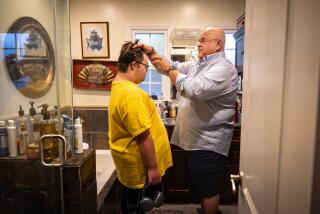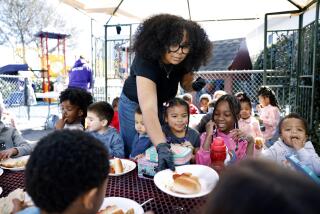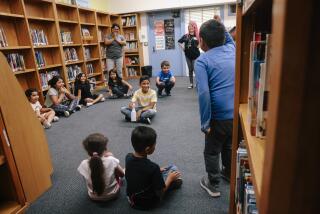Child Center Changes With Neighborhoods
It was sharing time at the day-care center run by United Cambodian Community Inc.
âLetâs talk about our weekend,â suggested teacher Diane Payton, surrounded by youngsters in a room containing a bird, a rabbit, a guinea pig and an aquarium filled with fish. âI stayed home this weekend.â
Sean Galloway, 4, had just one question: âDid you have any pizza?â
So it goes during a typical day at this child-care program operated in central Long Beach by Californiaâs largest Cambodian service organization, a nonprofit agency aimed at aiding Southeast Asian refugees. The halls are filled with childlike paintings. The centerâs young charges who are not in class romp happily in an asphalt-paved area out back.
Ironically, only one child is Cambodian. Most of the 25 others are black or Latino, although there are a few Asians from countries other than Cambodia.
Founded by Refugees
âThatâs our problem,â said Payton, who directs the child-care program under the auspices of an organization founded 10 years ago by a group of Cambodian refugees primarily interested in helping their countrymen.
Since then, the organization has expanded to offer a wide range of programs, including mental health referrals, job training and English-language instruction, serving an estimated 3,500 people annually out of seven offices in two counties.
But times have changed. Today, hemmed in by the restrictions of funding agencies and buffeted by changing demographics, less than half the agencyâs clients are Cambodian.
An office in Hollywood caters primarily to Armenian and Iranian immigrants. The organizationâs Norwalk office serves mostly Latinos. And in Long Beach, where the agency is based, the child-care program has recently undergone a dramatic ethnic shift.
âWeâve discussed changing our name,â said Vora H. Kanthoul, United Cambodian Communityâs associate executive director. âWeâre not here to serve only Cambodians; weâre a multiethnic agency.â
Kanthoul attributes the Hollywood and Norwalk situations to changing demographics. A few years ago, when those offices opened, he said, the neighborhoods they served were largely Asian. But gradually the Asians moved out and other groups moved in. And because the services offered were financed by the federal and state governments and therefore open to anyone, the agencyâs client list began to take on the complexion of the new neighborhoods.
Community Experience
Many agencies initially based in other ethnic communities have undergone similar transformations. The change at the Long Beach day-care program, however, has been accelerated by a peculiar congruence of circumstances.
When the program began in 1986, agency officials say, it was financed by a one-year grant from the city. True to its sponsoring organizationâs philosophy and purpose, the day-care center served a group of children made up of about 88% Southeast Asian refugees, including 63% from Cambodia.
Then the funding base changed. The social service grant expired. And, opting to get out of the child-care business altogether, the city decided to close four child-care centers run by its own Parks and Recreation Department under a separate state program.
State Grant Won
Frantically scrambling for funds to continue, the Cambodians successfully sought one of the four state grants that the city had given up. But along with the $114,000-a-year grant came certain restrictions. First, the state said, the Cambodian-run center had to give priority to children already enrolled in the four centers that were closing. And second, the parents of children attending the center had to either be working full time or enrolled in formal job training programs.
The last restriction eliminated virtually all of the centerâs Cambodian families, in which women traditionally stay at home. Part of the day-care centerâs purpose, administrators say, was to help woo Cambodian mothers away from that cultural orientation and into the job market by showing them that their children could be well cared for.
Gradual Acceptance
âOne of the best things we can do is ease them into it,â said Kathleen Hollingsworth, the agencyâs director of planning. âToo many things are expected at the same time of a person in cultural shock. Itâs like overload.â
Reaction to the loss of nearly all the child-care programâs Cambodian clients has been mixed. Payton decries the fact that Cambodian children may not be getting the kind of English-language exposure previously provided by the center, exposure that could give them a head start once they enter school. And Mary Soth, chairman of the Mayorâs Task Force on Child Care, sees the change as the loss of a potentially rich cultural experience for all the children involved.
For Entire Family
âItâs regrettable,â she said. âOne would think that the reason for the UCC center was to help support the entire family and be culturally very rich.â With the loss of the Cambodians, she said, both they and the non-Cambodian children have been deprived of that experience.
United Cambodian Community officials, for their part, are putting a positive face on the change. âItâs a success story,â Kanthoul said of the agency, which has grown from a few friends with part-time use of a borrowed desk to an organization with an annual budget of $2.4 million. âNot only do we serve our own people, but we serve everybody.â
Nonetheless, efforts are quietly being made to locate Cambodian families qualified to take advantage of the agencyâs child-care services, which are provided on a sliding scale from nothing to $5.95 a day. A recent $7,500 grant from the Long Beach Medical Assn. Auxiliary, for instance, will allow the center to expand its facilities enough to add seven children to the roster. âWe would like them to be Cambodian,â Hollingsworth said.
More to Read
Sign up for Essential California
The most important California stories and recommendations in your inbox every morning.
You may occasionally receive promotional content from the Los Angeles Times.










